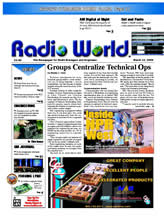
 |
|
|||||||||
|
|
 |
||||||||
 |
RF
Mixing Products by Mark Persons |
Radio World Article April 23, 2003 |
|
As more and more transmitters go on
the air, the potential for illegal and harmful RF mixing products increases.
You don't have to be in a big market for this to happen either.
The phenomenon happens with AM transmitters, FM transmitters, and can
even happen between an AM transmitter and an FM transmitter.
Any two AC (alternating current)
signals can mix in a non-linear device to create mathematical sum and difference
products. That is the engineer way
of saying that, for example, two FM station signals can mix and be heard on four
or more places on an FM receiver. We know that receivers vary in quality and have their own set
of problems. For this discussion,
let�s examine how radio stations comply with FCC rules and regulations on
their transmitted signals.
The FCC is letting stations take a
�marketplace approach� as to how good or bad they sound.
Of highest importance is whether or not a station is keeping it�s
signal within an allotted space in the RF spectrum.
That is where the "RF Mask" term came from.
In the case of FM stations, all emissions must be at least 25 dB below
carrier at 120 KHz away from the carrier frequency.
At 240 KHz, any emissions must be down at least 35 dB.
Beyond 600 KHz the power level of the transmitter determines the required
amount of attenuation. The ultimate
is 80 dB or more down from a 5 kW or larger transmitter.
The idea is that licensees are allowed to use their allotted portion of
the RF spectrum and must not interfere with other users in their portion of the
spectrum.
Radio broadcast transmitters are designed, built, and tested at factories
to meet or exceed all FCC specifications. That
is all well and good into a dummy load. The
difference comes when the transmitters are delivered to a site and connected to
an antenna. That antenna is good
for transmitting, but is equally good at receiving. It is amazing how many watts of power can come down a
transmission line, from an antenna, into a transmitter from a nearby station.
A transmitter PA (power amplifier), whether tube or solid state, makes an
excellent arena for mixing RF signals. The
PA is a non-linear device. You can
get a mix that makes a station illegal from another station 5 miles or more
away. The formula for the most
likely mix is 2A-B. That is twice
one frequency minus the other frequency. An
example is stations on 92.1 MHz and 94.1 MHz.
A signal from the 92.1 MHz station gets into the 94.1 MHz station causing
an unwanted transmitted product on 96.1 MHz.
(2 x 94.1 = 188.2 � 92.1 = 96.1 MHz.)
Others include 2B-A, B-A, and A+B.
It is very easy to see on an RF spectrum analyzer.
Connect to an RF sample on the output of a transmitter and setup the
analyzer so that station is in the center.
Sweep wide enough to include other stations in the area.
If a strong local station is 2 MHz below this station, you will see it 2
MHz to the left of center.
Any mixing that happens in this transmitter will appear 2 MHz to the
right of center.
You may need a notch filter to reduce the carrier of the transmitter you
are measuring so the dynamic range of the spectrum analyzer can be increased to
over 80 dB.
Sure enough, you will probably see the unwanted mix product that could
fall on a frequency near, or on top of, a weak station that is trying to get a
usable signal into the area.
In fact, there will always be mix products.
It is just a matter of degree.
Again, that degree is spelled out in FCC rules.
Those are the same rules that require harmonic attenuation of every
transmitter.
FM transmitters are not the only ones.
AM transmitters can have the same problem.
The same math applies.
A common problem is an FM transmitter running at an AM site.
If the AM operates at 1000 KHz, then look for unwanted signals on the FM
transmitter that are 1000 KHZ (1 MHz) above and below the FM assigned frequency.
Usually these problems happen when the AM signal gets into the composite
input of the FM station exciter.
Checking for mixing products is an important measurement to make whenever
a new transmitter moves into the neighborhood.
The transmitters most vulnerable to problems are the lower power ones
that are getting a hefty signal from a nearby high power transmitter. |
Mark Persons, ham W0MH, is certified by the Society of Broadcast Engineers as a Professional Broadcast Engineer with more than 30 years experience. He has written numerous articles for Radio World over the years. His Web site is www.mwpersons.com From the Radio World April 23, 2003 issue http://www.rwonline.com
See you further down the road.
I'll leave the soldering iron on for you. |
|
Questions? Email Mark Persons: teki@mwpersons.com |
|
.